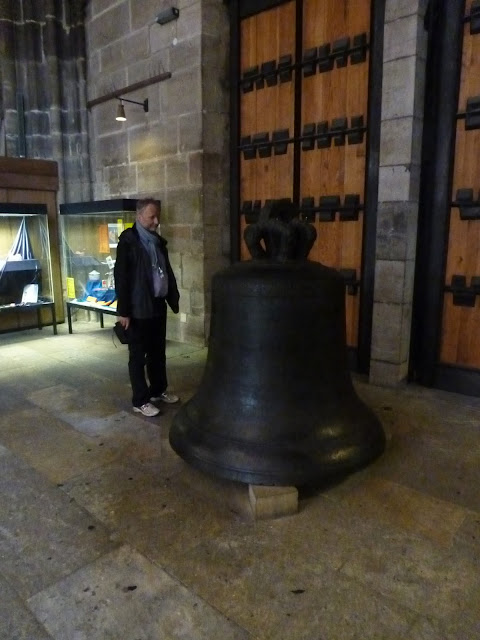Friday, April 1, 2016
Sankt Lorenz, Nuremberg
For no apparent reason, here are some of the many photos I took of Sankt Lorenz Kirche in Nuremberg two years ago.
As always with my photos, they are freely available, especially to educators.
Open sourcing forever!
From behind the high altar in the ambulatory looking west into the nave.
The very late 20th century high altar; a post War rebuild
The crucifix behind the altar which a guidebook somewhere said is attributed to Tilman Riemenschneider; I think 'attributed' is the operative word. It doesn't look like any work by Riemenschneider I've seen. It's still magnificent though.
*NOTE:
Gerrit informs me that this cross is a work by Veit Stoss. I was thinking this might be by Stoss, the expression on the face, the drapery, but I wasn't sure. I was only sure that this was not by Riemenschneider or his circle.
A 15th century painted altarpiece behind the high altar
The city of Nuremberg complete with the Castle and the spires of the city's churches, including the Lorenzkirche, in the background of the altarpiece. The 15th century didn't care about archaeological accuracy. There was no reason why the Blessed Virgin and her saints couldn't hold court in Nuremberg.
A reliquary complete with saintly bones...and in a Lutheran church!
Yes, those really are bones, femurs it looks like to me.
A glimpse of Jackob Grimm's tracery vaults in the ceiling of the choir, viewed from the ambulatory behind the altar.
Veit Stoss' great Annunciation is always worth an encore
More of Veit Stoss' Annunciation.
I left out the many photos I took of Adam Kraft's spectacular sacrament house. I plan to do a separate post on Kraft eventually.
A spiral staircase that I think went up to a chantry
Escutcheons of prominent Nuremberg mercantile families. Like so many late Medieval and Renaissance cities in Europe, Nuremberg was a plutocratic oligarchy, and a little stricter than most. It was one of the few cities that did not have a guild system and that positively forbade trades from organizing. For awhile, Nuremberg grew very rich by being so fortunately situated astride the main trade routes from Venice to Flanders, and from France to eastern Europe. That changed with the warfare that followed the Reformation, and the advent of the global economy in the 16th century.
A rat. Peter Meyer told be the story behind this little detail, and alas, I've forgotten it. That's one thing I love about Medieval and late Medieval/Renaissance churches is all the delightful marginalia throughout these buildings. I wonder sometimes if pietism and later modern form was really worth the sacrifice of all this playfulness.
A painted boss in Jackob Grimm's ceiling tracery. As I look at it, it might be Saint Lawrence. He looks like he's wearing a deacon's dalmatic.
Peter Meyer with a very large bell just inside the west door
The bells of the Lorenzkirche
The people stopping and listening to the bells in this video was very much my experience in Nuremberg. Some of the people in this video are tourists, but most are locals. I remember enjoying a sandwich featuring the local wurst at an outdoor cafe near the Lorenzkirche on a pleasant Saturday evening when all the bells in the city began ringing at sunset announcing the beginning of the Christian Sabbath. I remember just about everyone stopping to listen.
Subscribe to:
Post Comments (Atom)















3 comments:
From high pitch to low, a glorious cacaphony! Thanks for this, Doug.
The 'Riemenscheider' Christ is by Veit Stoss.
Thanks Gerrit. I've included a note about your identification of Veit Stoss in the post.
I suspected it might be Stoss, but wasn't sure.
Post a Comment